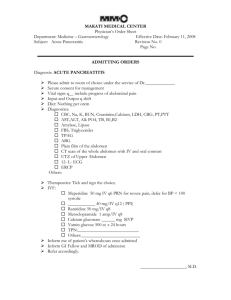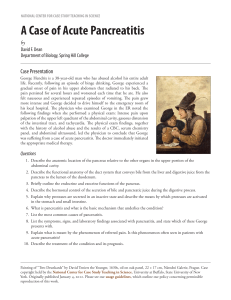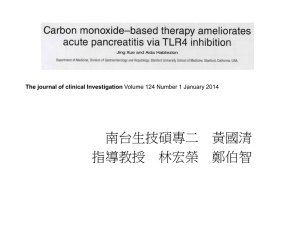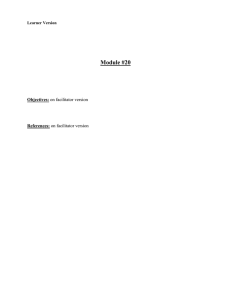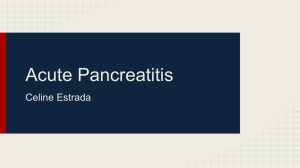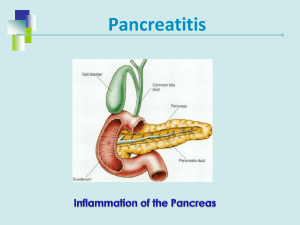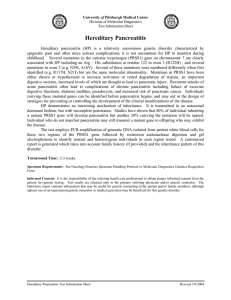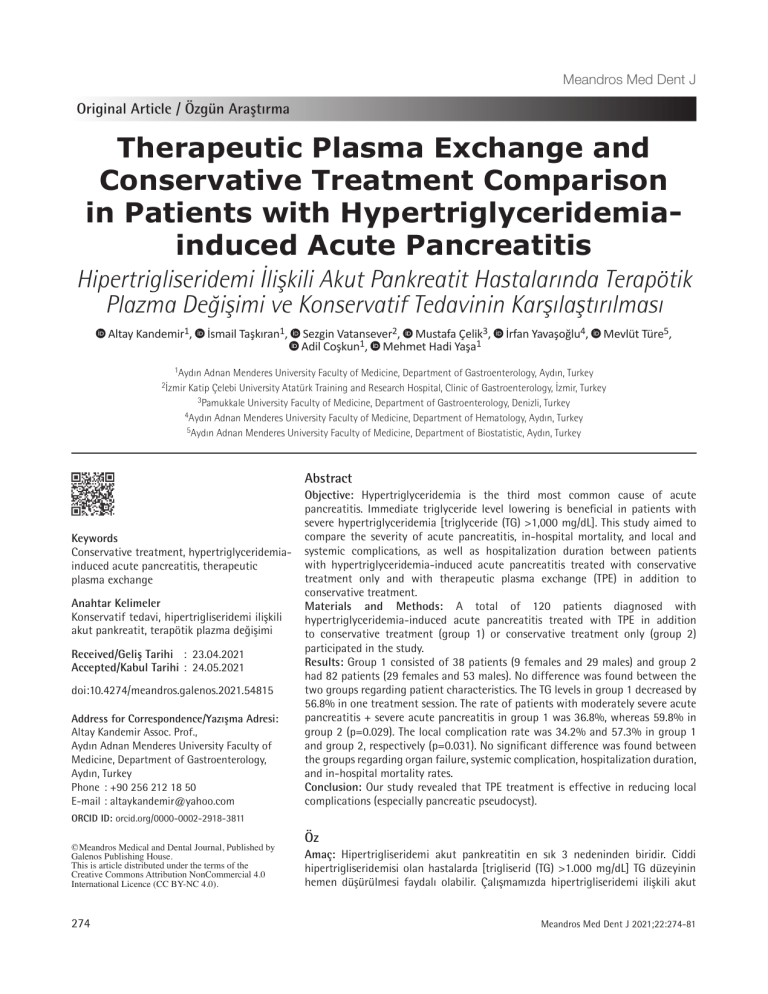
Meandros Med Dent J Original Article / Özgün Araştırma Therapeutic Plasma Exchange and Conservative Treatment Comparison in Patients with Hypertriglyceridemiainduced Acute Pancreatitis Hipertrigliseridemi İlişkili Akut Pankreatit Hastalarında Terapötik Plazma Değişimi ve Konservatif Tedavinin Karşılaştırılması Altay Kandemir1, İsmail Taşkıran1, Sezgin Vatansever2, Mustafa Çelik3, Adil Coşkun1, Mehmet Hadi Yaşa1 İrfan Yavaşoğlu4, Mevlüt Türe5, 1Aydın Adnan Menderes University Faculty of Medicine, Department of Gastroenterology, Aydın, Turkey Katip Çelebi University Atatürk Training and Research Hospital, Clinic of Gastroenterology, İzmir, Turkey 3Pamukkale University Faculty of Medicine, Department of Gastroenterology, Denizli, Turkey 4Aydın Adnan Menderes University Faculty of Medicine, Department of Hematology, Aydın, Turkey 5Aydın Adnan Menderes University Faculty of Medicine, Department of Biostatistic, Aydın, Turkey 2İzmir Abstract Keywords Conservative treatment, hypertriglyceridemiainduced acute pancreatitis, therapeutic plasma exchange Anah­tar Ke­li­me­ler Konservatif tedavi, hipertrigliseridemi ilişkili akut pankreatit, terapötik plazma değişimi Received/Geliş Ta­rihi : 23.04.2021 Accepted/Ka­bul Ta­ri­hi : 24.05.2021 doi:10.4274/meandros.galenos.2021.54815 Ad­dress for Cor­res­pon­den­ce/Ya­zış­ma Ad­re­si: Altay Kandemir Assoc. Prof., Aydın Adnan Menderes University Faculty of Medicine, Department of Gastroenterology, Aydın, Turkey Phone : +90 256 212 18 50 E-mail : altaykandemir@yahoo.com Objective: Hypertriglyceridemia is the third most common cause of acute pancreatitis. Immediate triglyceride level lowering is beneficial in patients with severe hypertriglyceridemia [triglyceride (TG) >1,000 mg/dL]. This study aimed to compare the severity of acute pancreatitis, in-hospital mortality, and local and systemic complications, as well as hospitalization duration between patients with hypertriglyceridemia-induced acute pancreatitis treated with conservative treatment only and with therapeutic plasma exchange (TPE) in addition to conservative treatment. Materials and Methods: A total of 120 patients diagnosed with hypertriglyceridemia-induced acute pancreatitis treated with TPE in addition to conservative treatment (group 1) or conservative treatment only (group 2) participated in the study. Results: Group 1 consisted of 38 patients (9 females and 29 males) and group 2 had 82 patients (29 females and 53 males). No difference was found between the two groups regarding patient characteristics. The TG levels in group 1 decreased by 56.8% in one treatment session. The rate of patients with moderately severe acute pancreatitis + severe acute pancreatitis in group 1 was 36.8%, whereas 59.8% in group 2 (p=0.029). The local complication rate was 34.2% and 57.3% in group 1 and group 2, respectively (p=0.031). No significant difference was found between the groups regarding organ failure, systemic complication, hospitalization duration, and in-hospital mortality rates. Conclusion: Our study revealed that TPE treatment is effective in reducing local complications (especially pancreatic pseudocyst). ORCID ID: orcid.org/0000-0002-2918-3811 © Meandros Medical and Dental Journal, Published by Galenos Publishing House. This is article distributed under the terms of the Creative Commons Attribution NonCommercial 4.0 International Licence (CC BY-NC 4.0). 274 Öz Amaç: Hipertrigliseridemi akut pankreatitin en sık 3 nedeninden biridir. Ciddi hipertrigliseridemisi olan hastalarda [trigliserid (TG) >1.000 mg/dL] TG düzeyinin hemen düşürülmesi faydalı olabilir. Çalışmamızda hipertrigliseridemi ilişkili akut Meandros Med Dent J 2021;22:274-81 Kandemir et al. Hypertriglyceridemia-induced Acute Pancreatitis 275 pankreatit hastalarına uygulanan konservatif tedavi ile konservatif + terapötik plazma değişimi tedavilerini mortalite, hastane yatış süresi ve lokal-sistemik komplikasyonları baz alarak karşılaştırdık. Gereç ve Yöntemler: Hipertrigliseridemi ilişkili akut pankreatit tanısı olup konservatif tedavi + terapötik plazma değişimi tedavisi alanlar (grup 1) ve sadece konservatif tedavi alan (grup 2) toplam 120 hasta çalışmaya alınmıştır. Bulgular: Grup 1’de 38 (9 kadın, 29 erkek), grup 2’de 82 (29 kadın, 53 erkek) hasta mevcuttu. İki grup arasında hasta özellikleri açısından fark yoktu. Grup 1’de bir seans tedavi sonrası TG düzeyi %56,8 azaldı. Grup 1 hastalarının %36,8’i orta + ciddi düzeyde pankreatit iken, grup 2 hastalarında bu oran %59,8 idi (p=0,029). Lokal komplikasyon oranları grup 1 ve grup 2 hastalarda sırası ile %34,2 ve %57,3 idi (p=0,031). Gruplar arasında organ yetmezliği, sistemik komplikasyonlar, hastane yatış süresi ve hastane içi mortalite açısından fark yoktu. Sonuç: Çalışmamızda, terapötik plazma değişimi tedavisi lokal komplikasyonları (özellikle pankreatik psödokist) azaltmada etkili olarak bulunmuştur. Introduction Acute pancreatitis (AP) is a common disorder having high morbidity and mortality. Although the majority of patients have a mild clinical course, the mortality rate may reach 30% in patients with severe pancreatitis (1). Hypertriglyceridemia (HTG) is the third most common cause of AP following gallstones and alcohol; it is responsible for 1-10% of AP cases (2). HTG may be primary, or it may develop secondary to alcohol abuse, diabetes mellitus (DM), pregnancy, obesity, hypothyroidism, nephrotic syndrome, or various medications such as β-blockers, oral retinoids. It is believed that AP risk is elevated in patients with triglyceride (TG) level above 1,000 mg (3). HTG has been reported to be more related to mortality, severe pancreatitis, complications, and recurrence, compared to other AP etiologies (4-6). Therefore, it is important to assess the severity and prognosis of patients with hypertriglyceridemia-induced acute pancreatitis (HTG-AP) in the early period; this helps in both individualizing the treatment and improving the prognosis of the disease. The Balthazar score plays an important role in determining the severity of AP and has been in use for over three decades (7,8). The treatment principles in AP are fasting, lowcalorie infusions (in theacute phase), using anti-lipid agents (fenofibrate, gemfibrozil, niacin, omega-3 fatty acids), low-molecular-weight heparin (LMWH), and insulin. Non-pharmacological treatment methods such as therapeutic plasma exchange (TPE) have started to be used recently. In our study, we aimed to compare our conservatively treated HTG-AP patients to our HTG-AP patients in whom TPE was added to the conservative treatment method, regarding AP severity, duration of hospitalization, in-hospital mortality, organ failure, and local/systemic complication rates, based on the revised Atlanta classification. Materials and Methods Study Population A total of 120 patients (38 females and 82 males, mean age of 41.1±8) diagnosed as HTG-AP and treated with conservative method only or with TPE added to conservative treatment in the gastroenterology departments of the three different university hospitals were enrolled in this study. While TPE + conservative treatment was performed in one university hospital, only conservative treatment was administered in the other two university hospitals. All patient data were retrospectively obtained from the electronic medical records. The diagnosis of HTG-AP was made based on TG levels above 1,000 mg/dL and the presence of at least two of the three diagnostic criteria for AP (abdominal pain, more than 3-fold increased serum lipase level, and characteristic imaging findings). We did not perform the genetic analysis to determine the type of hyperlipidemia in our patients. Patient data were recorded including age, gender, alcohol consumption, the presence of diabetes mellitus, previous AP exacerbations and related therapeutic apheresis, together with previous medical treatment for hyperlipidemia. Also, values of fasting blood glucose, blood urea nitrogen, creatinine, calcium (Ca), alanine aminotransferase, lactic dehydrogenase, amylase, lipase, TG, C-reactive protein (CRP), leukocyte, hematocrit were collected for each patient. The reduction in TG was calculated using the values at admission and the day after TPE. Contrast-enhanced CT scans of the abdomen were performed within the three days following admission in all patients. The Balthazar score was confirmed by Meandros Med Dent J 2021;22:274-81 276 Kandemir et al. Hypertriglyceridemia-induced Acute Pancreatitis two independent radiologists. Clinical course was reevaluated after 24, 48 and 72 h. Local complication was re-evaluated after 48-72 h and 4 weeks.The severity of pancreatitis was determined taking into account the overall course of the patient after discharge. According to the 2012 revision of the Atlanta classification and the definitions by international consensus, the severity of AP was categorizedin three groups as mild acute pancreatitis (MAP), moderately severe acute pancreatitis (MSAP), and severe acute pancreatitis (SAP). MAP lacks organ failure, local or systemic complications,and exacerbation of coexisting disease. The MSAP manifests transient organ failure (≤48 hours), local complications, and/or exacerbation of coexisting disease. SAP is defined by persistent organ failure (≥48 hours). Organ failure involves pulmonary failure, defined as an arterial PO2<mmHg on room air or the requirement for mechanical ventilation. Cardiovascular failure is defined as the development of shock (systolic pressure <90 mmHg) that persists following fluid resuscitation. Renal failure is defined as a serum creatinine level >2 mg/dL after rehydration or the need for hemodialysis in patients without preexisting renal disease. Local complications are acute peripancreatic fluid collection (APFC), pancreatic pseudocyst, walled-off necrosis, and necrosis. The systemic complication was defined as an exacerbation of preexisting comorbidity, precipitated by AP (9). The patients were divided into two groups as treated with TPE in addition to the conservative treatment (group 1) and treated with conservative treatment only (group 2). In-hospital mortality, organ failure, duration of hospitalization, local and systemic complication rates were compared between the two groups. The study’s ethics committee approval was obtained from the Adnan Menderes University NonInvasive Clinical Research Ethics Committee that the study was conducted (protocol no: 2017/1253, date: 26.10.2017). Conservative Treatment Intravenous hydration and pain management were administered in addition to the discontinuation of oral feeding. LMWH was used for thrombosis prophylaxis. Insulin was administered when glucose level was >150 mg/dL. Meandros Med Dent J 2021;22:274-81 Plasma Exchange Procedures A haemonetics MCS + (Haemonetics Corp. Braintree, USA) was used in all TPE procedures. Vascular access was obtained with a double-or singlelumen catheter usually placed in the femoral vein; peripheral veins were used for the return of blood in some cases. A central venous catheter was used in cases with the inappropriate vasculature. During each TPE session, one (rarely up to two) estimated plasma volume was exchanged and replaced with a bicarbonate-based electrolyte solution with 30 g/L albumin added. Anticoagulation during TPE was achieved with unfractionated heparin or trisodium citrate (either 4% or 15% solution; the protocol included intravenous Ca substitution). Statistical Analysis The data were analyzed by using Statistical Package for Social Sciences version 17.0 (SPPP, Inc.; Chicago, IL, USA). The descriptive statistics of categorical variables were recorded as number (%), and the chi-square test was used for intergroup comparison. The conformity of continuous variables to anormal distribution was assessed by the Kolmogorov-Smirnov test. Since age had a normal distribution, its descriptive statistical results were shown as mean + standard deviation, and the t-test in independent groups was used for the comparison of the two groups. Since the other continuous variables were not normally distributed, their descriptive statistical results were shown as median (25-75%), and the Mann-Whitney U test was used for intergroup comparison of these variables. The chi-square automatic interaction detector analysis was used to determine the factors effective in identifying the presence of local complications. P<0.05 was considered as statistically significant. Results A total of 120 patients were included in the study between January 2007-January 2019. Group 1 included 38 patients (9 females and 29 males, mean age of 40.3±7), and group 2 included 82 patients (29 females and 53 males, mean age of 41.6±10.7). The patient characteristics were summarized in Table 1. No significant difference was found between the groups regarding age and gender. There were 17 DM patients in group 1 (44.7%), whereas DM was present in 33 patients in group 2 (40.2%) (p=0.800); insulin Kandemir et al. Hypertriglyceridemia-induced Acute Pancreatitis infusion was administered in all of these patients. LMWH was administered in all patients in doses of venous thromboembolism. The time between the initiation of abdominal pain or hospital admission and plasma exchange procedure was 10±4 (range 4-24) hours in average. TPE was well-tolerated. Vomiting in six patients, palpitation and tachycardia in four patients, asymptomatic hypotension in three patients, occurred. Two cases had hypervolemia which was successfully treated with IV furosemide. Hemolysis was not detected in any of the patients. Occlusion of the catheter was seen in one patient. TPE was discontinued in none of these patients. When the patients were evaluated according to the revised Atlanta classification, 24 MAP (63.2%), 11 MSAP (28.9%) and 3 SAP (7.9%) patients were found in group 1 and 33 MAP (40.2%), 39 MSAP (47.6%) and 10 SAP (12.2%) were found in group 2. When the patients were redistributed as MAP and MSAP+SAP, the ratio of MSAP+SAP was 36.8 in group 1, whereas it was 59.8% in group 2 (p=0.029). There was no significant difference between the groups regarding organ failure (pulmonary failure, renal failure, and cardiovascular failure) (p=0.680) (Table 2). The local complications were summarized in Table 2. 277 Systemic complicationswere observed in two (5.3%) patients in group 1 and five patients (6.1%) in group 2 (p=0.610). The mean duration of hospitalization was found as 6 (4-8) days in group 1 and 5 (3.75-8) days in group 2. The in-hospital mortality rate was found as 2.6% in group 1 and 2.4% in group 2. The overall in-hospital mortality rate, covering all patients, was 2.5%. There was no difference between groups regarding the initial TG level (p=0.078). The pre- and post-TPE levels of TG were found as 1,579 (1,406-3,323) mg/ dL and 682 (454-1,107) mg/dL, respectively (Table 3). The TG level was found to be reduced by 56.8% following one TPE session. The average time between the onset of abdominal pain or the admission to the hospital and the plasma exchange procedure was 11±3.9 (range 4-24) hours. No significant relationships were determined between the initial TG or CRP levels and local/systemic complications and the in-hospital mortality rate. Discussion HTG has become one of the significant causes of AP due to changes in living conditions and lifestyle. The demographic characteristics of patients can be listed as young, male, with secondary factors such as DM and alcohol abuse, and frequently, the previous Table 1. Characteristics of patients Group 1, n=38 Group 2, n=82 p Age (year) 40.3±7 41.6±10.7 0.497 Male gender (%) 76.3 64.6 0.285 Leukocyte (mm ) 13.250 (9.500-17.815) 11,300 (8,800-14,500) 0.059 Htc (%) 44.3 (38.4-45.8) 41.5 (36-44) 0.051 LDH (U/L) 199 (161-281) 256 (201-295) 0.067 Ca (mg/dL) 9.2 (8.7-9.5) 8.9 (8.3-9.3) 0.052 Glucose (mg/dL) 124 (100-240) 153 (106-276) 0.578 Amylase (U/L) 212 (70-528) 253 (103-725) 0.226 Initial triglyceride (mg/dL) 1579 (1.406-3.323) 1,350 (1,104-1,751) 0.078 Known HTG story (%) 15 (39.5%) 33 (40.2%) 1.000 Known pancreatitis story (%) 11 (28.9%) 24 (29.3%) 1.000 Alcohol abuse (%) 6 (15.8%) 11(13.4%) 0.950 DM (%) 17 (44.7%) 39 (40.2%) 0.800 Pregnancy (%) 3 (7.9%) 1 (1.2%) 0.250 3 Htc: Hematocrit, LDH: Lactic dehydrogenase, Ca: Calcium, DM: Diabetes mellitus, HTG: Hypertriglyceridemia Meandros Med Dent J 2021;22:274-81 278 Kandemir et al. Hypertriglyceridemia-induced Acute Pancreatitis history of pancreatitis (10). In our study, also, the patients were young (mean age 41.1+8), mostly male (68.3% male), with a previous history of pancreatitis (29.6%), DM (46.7%), and alcohol abuse (14.2%). The probable mechanism of HTG-AP is hydrolysis of plasma TG into free fatty acids by pancreatic lipase, which are toxic to pancreatic endothelium and acinar cells (4). Conservative treatment (fasting, lipidlowering drugs, intravenous hydration) is not strong enough in reducing excessively elevated TG levels in patients with HTG-AP (11). In contrast, plasmapheresis might remove excessive lipid from serum in about two hours. Although the benefit of plasmapheresis is considered to be due to the rapid reduction of TG levels, removing significantly increased proteases from the blood and replacing the depleted protease inhibitors might also be augmenting the treatment process (12). Since its first description by Betteridge et al. (13) in 1978, numerous case reports (12) and case series (14) have been published about the use of plasmapheresis in the treatment of patients with HTG-AP. There is no randomized controlled study demonstrating the superiority of plasmapheresis against conservative treatment. However, it is recommended as a category III indication in the recent guideline (disorder for which the optimum role of apheresis therapy is not established, the individualized decision is necessary) in acute hypertriglyceridemic pancreatitis (15). While reduction of TG level is achieved at the first or the second day of plasmapheresis, it is achieved in the following days of conservative treatment, and usually, it does not show a linear course. The clinical data about the effectivity of apheresis are limited by relief of clinical symptoms such as abdominal pain, nausea, vomiting, and laboratory findings such as triglyceride level. There are few studies about the effects of apheresis on the severity of AP. Yeh et al. (16) and Lennertz et al. (17) reported that they had achieved improvements in TG levels up to 70% and in clinical status and laboratory findings of their patients. In our study also, we achieved a 56.8% reductionof TG levels in TPE group after one TPE session. The computed tomography severity index (CTSI) is a widely used clinical imaging scoring system in patients with AP which is positively correlated with mortality and development of complications (7,8). CTSI can show volume, size, and contour of the pancreas, together with surrounding tissue lesions. It can also guide in diagnosis and staging of AP by showing pancreas necrosis and fluid collection. In one study, it was shown that CTSI could predict the prognosis of AP correctly 48-72 hours after admission Table 2. Patients outcomes Group 1, n=38 Group 2, n=82 p Local complication (%) 13 (34.2%) 47 (57.3%) 0.031 APFC (%) 10 (26.3%) 31 (37.8%) 0.249 Pancreatic pseudocyst (%) 0 (0%) 9 (10.9%) 0.023 Walled-off necrosis + necrosis (%) 2+1 (7.9%) 1+6 (8.6%) 0.732 Systemic complication (%) 2 (5.3%) 5 (6.1%) 0.610 Median hospital stay (day) 6 (4-8) 5 (3.75-8) 0.345 CRP>150 (%) 9 (23.7%) 8 (9.8%) 0.145 Balthazar score D and E (%) 13 (34.2%) 47 (57.3%) 0.031 Pulmonary failure 2 (5.3%) 6 (7.3%) Renal failure 2 (5.3%) 5 (6.1%) Cardiovascular failure 1 (2.6%) 4 (4.9%) In-hospital mortality (%) 1 (2.6%) 2 (2.4%) 0.680 0.820 APFC: Acute peripancreatic fluid collection, CRP: C-reactive protein Table 3. Comparison of serum trygliceride, before and after therapeutic plasma exchange treatment in each patient Triglyceride (mg/dL) Meandros Med Dent J 2021;22:274-81 Before After p 1,579 (1.406-3.323) 682 (454-1,107) <0.001 Kandemir et al. Hypertriglyceridemia-induced Acute Pancreatitis to the hospital (18). CTSI scoring system has a superior performance in predicting local complications in patients with HTG-AP (19,20). Lloret Linares et al. (21) reported that severe pancreatitis (need for intensive care, CRP>150 mg/dL or Balthazar score >C) had been observed in 71.5% of patients. However, no relationship was observed between TG levels and the disease severity. In our study, the rate of patients with CRP>150 mg/dL or Balthazar score >C was found as 55.8%. No significant associations of initial TG level and CRP levels with in-hospital mortality and local/ systemic complication rates were observed. The use of plasmapheresis is limited due to its high cost in addition to its unavailability in every hospital. Thus, many healthcare centers offer only conservative treatment for their patients with HTG-AP. Due to the lack of randomized controlled studies, it is not certain whether plasmapheresis improves mortality and morbidity in patients with HTG-AP or not. Gubensek et al. (14) reported that there was no relationship between initial TG levels and severity of the disease, mortality rates and hospital staying period. Plasma exchange, performed for once or twice, resulted in the reduction of TG faster than expected. Plasma exchange was found to be related to the low complication rate. The in-hospital mortality rate was found to be low (5%), and the delay in plasma exchange therapy had not affected the hospital mortality. In a study of Nakhoda et al. (22), it was reported that, although TG levels were found to be reduced rapidly, there was no significant difference between pre- and postTPE evaluated Acute Physiology and Chronic Health Evalation II (APACHE scores). In a retrospective study of Chen et al. (23) in which HTG-AP patients were divided into two groups as non-plasmapheresis (group 1) and plasmapheresis (group 2), TG levels were found to be 65.8% reduced in plasmapheresis group. There was no significant difference between the two groups and also the patients with severe pancreatitis (defined by Ranson’s score >3) regarding total mortality, systemic and local complication rates. In the study of He WH et al. comparing HTG-AP patients treated with highvolume hemofiltration (HVHF) or LMWH + insulin, LMWH+insulin treatment was found to be superior in reducing TG levels, whereas no significant differences were found in terms of local pancreatic complications (p>0.05), need for surgical intervention (p=0.49), 279 mortality rate (p=0.49), and duration of hospitalization (p=0.144) (24). Wang et al. (25) conducted a study on 144 HTG-AP patients treated with conservative treatment, and 91 (63.1%) of patients were classified as MSAP and SAP. APFC, acute necrotic collections, and pseudocyst were observed in 66 (45.8%), 13 (9%) and 5 (3.5%) of their patients as local complications, respectively. Systemic complications developed in 6 (4.2%) patients, whereas mortality was observed in 8 (5.5%) patients. MSAP and SAP, together with local complications and mortality were found to be related to elevation of TG level. In our retrospective study, we divided our patients according to the revised Atlanta Classification. MAP and MSAP+SAP rates were 63.2% and 36.8% in group 1, whereas these rates were 40.2% and 59.8% in group 2, respectively (p=0.029). Local complication rate was 34.2% in group 1 and 57.3% in group 2 (p=0.031). The occurrence of APFC and walled-off necrosis+necrosis were found to be similar in two groups. Pancreatic pseudocyst was not observed in group 1, whereas it was observed in 9 (10.9%) patients in group 2 (p=0.023) (Table 2). Total in-hospital mortality rate was found to be 2.5%. There were no statistically significant differences between the groups regarding organ failure, systemic complication, duration of hospitalization, and in-hospital mortality rates. However, it was observed that TPE treatment led to the significant reduction of AP severity and local complication rate since TPE is consistently helpful during the acute inflammatory phase. The limitation of our study was its retrospective design. Also add to the limitations of the study, that due to its design (3 different hospitals) the effect of other differences in treatment practices or patient characteristics on outcome cannot be excluded. The distinguishing feature of our study is that it is the first study comparing HTG-AP patients having TPE with those having conservative treatment in terms of mortality, length of hospitalization, disease severity, local and systemic complications, in accordance with the revised Atlanta classification. Conclusion Plasmapheresis is an effective and useful method in reducing the excessively high TG levels in patients with HTG-AP. However, the use of plasmapheresis is limited to specific centers since it is a quite expensive Meandros Med Dent J 2021;22:274-81 280 Kandemir et al. Hypertriglyceridemia-induced Acute Pancreatitis treatment option. Apheresis should be continued until the TG level is reduced below 500-1,000 mg/dL. TPE may be effective in reducing local complications (especially pancreatic pseudocyst) but has no effect on organ failure and hospitalization duration; and optimal timing or how to select appropriate patients for this modality remains to be elucidated in further studies. Ethics Ethics Committee Approval: The study’s ethics committee approval was obtained from the Adnan Menderes University Non-Invasive Clinical Research Ethics Committee that the study was conducted (protocol no: 2017/1253, date: 26.10.2017). Informed Consent: All patient data were retrospectively obtained from the electronic medical records Peer-review: Externally peer-reviewed. Authorship Contributions Concept: A.K., İ.Y., M.Ç., Design: İ.T., A.C., S.V., Fundings: M.H.Y., Data Collection or Processing: A.K., S.V., M.Ç., İ.Y., A.C., Analysis or Interpretation: M.T., Literature Search: İ.T., A.K., Writing: A.K., İ.T., Critical Review: A.K., M.H.Y. Conflict of Interest: No conflict of interest was declared by the authors. Financial Disclosure: The authors declared that this study received no financial support. 7. 8. 9. 10. 11. 12. 13. 14. 15. 16. References 1. 2. 3. 4. 5. 6. Whitcomb DC. Clinical practice. Acute pancreatitis. N Engl J Med 2006; 354: 2142-50. Valdivielso P, Ramírez-Bueno A, Ewald N. Current knowledge of hypertriglyceridemic pancreatitis. Eur J Intern Med 2014; 25: 689-94. Yadav D, Pitchumoni CS. Issues in hyperlipidemic pancreatitis. J Clin Gastroenterol 2003; 36: 54-62. Hofbauer B, Friess H, Weber A, Baczako K, Kisling P, Schilling M, et al. Hyperlipaemiaintensifiesthecourse of acuteoedematousandacutenecrotisingpancreatitis in therat. Gut 1996; 38: 753-8. Huang YX, Jia L, Jiang SM, Wang SB, Li MX, Yang BH. Incidence and clinical features of hyperlipidemic acute pancreatitis from Guangdong, China: a retrospective multicenter study. Pancreas 2014; 43: 548-52. Carr RA, Rejowski BJ, Cote GA, Pitt HA, Zyromski NJ. Systematic review of hypertriglyceridemia-induced acute pancreatitis: A more virulent etiology? Pancreatology 2016; 16: 469-76. Meandros Med Dent J 2021;22:274-81 17. 18. 19. 20. 21. Balthazar EJ, Ranson JH, Naidich DP, Megibow AJ, Caccavale R, Cooper MM. Acute pancreatitis: prognostic value of CT. Radiology 1985; 156: 767-72. Sahu B, Abbey P, Anand R, Kumar A, Tomer S, Malik E. Severity assessment of acute pancreatitis using CT severity index and modified CT severity index: Correlation with clinical outcomes and severity grading as per the Revised Atlanta Classification. Indian J Radiol Imaging 2017; 27: 152-60. Banks PA, Bollen TL, Dervenis C, Gooszen HG, Johnson CD, Sarr MG, et al. Classification of acute pancreatitis--2012: revision of the Atlanta classification and definitions by international consensus. Gut 2013; 62: 102-11. Click B, Ketchum AM, Turner R, Whitcomb DC, Papachristou GI, Yadav D. The role of apheresis in hypertriglyceridemia-induced acute pancreatitis: A systematic review. Pancreatology 2015; 15: 313-20. Ewald N, Kloer HU. Severe hypertriglyceridemia: an indication for apheresis? Atheroscler Suppl 2009; 10: 49-52. Yeh JH, Chen JH, Chiu HC. Plasmapheresis for hyperlipidemic pancreatitis. J Clin Apher 2003; 18: 181-5. Betteridge DJ, Bakowski M, Taylor KG, Reckless JP, de Silva SR, Galton DJ. Treatment of severe diabetic hypertriglyceridaemia by plasma exchange. Lancet 1978; 1: 1368. Gubensek J, Buturovic-Ponikvar J, Romozi K, Ponikvar R. Factors affecting outcome in acute hypertriglyceridemic pancreatitis treated with plasma exchange: an observational cohort study. PLoS One 2014; 9: e102748. Schwartz J, Padmanabhan A, Aqui N, Balogun RA, ConnellySmith L, Delaney M, et al. Guidelines on the Use of Therapeutic Apheresis in Clinical Practice-Evidence-Based Approach from the Writing Committee of the American Society for Apheresis: The Seventh Special Issue. J Clin Apher 2016; 31: 149-62. Yeh JH, Lee MF, Chiu HC. Plasmapheresis for severe lipemia: comparison of serum-lipid clearance rates for the plasmaexchange and double-filtration variants. J Clin Apher 2003; 18: 32-6. Lennertz A, Parhofer KG, Samtleben W, Bosch T. Therapeutic plasma exchange in patients with chylomicronemia syndrome complicated by acute pancreatitis. Ther Apher 1999; 3: 227-33. Greer SE, Burchard KW. Acute pancreatitis and critical illness: a pancreatic tale of hypoperfusion and inflammation. Chest 2009; 136: 1413-9. Qiu L, Sun RQ, Jia RR, Ma XY, Cheng L, Tang MC, et al. Comparison of Existing Clinical Scoring Systems in Predicting Severity and Prognoses of Hyperlipidemic Acute Pancreatitis in Chinese Patients: A Retrospective Study. Medicine (Baltimore) 2015; 94: e957. Yang L, Liu J, Xing Y, Du L, Chen J, Liu X, et al. Comparison of BISAP, Ranson, MCTSI, and APACHE II in Predicting Severity and Prognoses of Hyperlipidemic Acute Pancreatitis in Chinese Patients. Gastroenterol Res Pract 2016; 2016: 1834256. Lloret Linares C, Pelletier AL, Czernichow S, Vergnaud AC, Bonnefont-Rousselot D, Levy P, et al. Acute pancreatitis in a Kandemir et al. Hypertriglyceridemia-induced Acute Pancreatitis cohort of 129 patients referred for severe hypertriglyceridemia. Pancreas 2008; 37: 13-2. 22. Nakhoda S, Zimrin AB, Baer MR, Law JY. Use of the APACHE II score to assess impact of therapeutic plasma exchange for critically ill patients with hypertriglyceride-induced pancreatitis. Transfus Apher Sci 2017; 56: 123-6. 23. Chen JH, Yeh JH, Lai HW, Liao CS. Therapeutic plasma exchange in patients with hyperlipidemic pancreatitis. World J Gastroenterol 2004; 10: 2272-4. 281 24. He WH, Yu M, Zhu Y, Xia L, Liu P, Zeng H, et al. Emergent Triglyceridelowering Therapy With Early High-volume Hemofiltration Against Low-Molecular-Weight Heparin Combined With Insulin in Hypertriglyceridemic Pancreatitis: A Prospective Randomized Controlled Trial. J Clin Gastroenterol 2016; 50: 772-8. 25. Wang SH, Chou YC, Shangkuan WC, Wei KY, Pan YH, Lin HC. Relationship between Plasma Triglyceride Level and Severity of Hypertriglyceridemic Pancreatitis. PLoS One 2016; 11: e0163984. Meandros Med Dent J 2021;22:274-81
